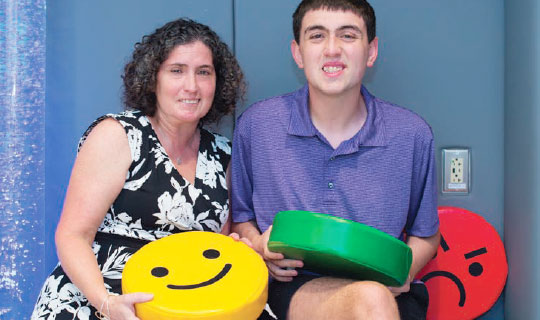The New Pediatric Emergency Department Features a Special Space for Children with Sensory Issues
 Dina Elkins has never had to bring her 17-year-old son, Hunter, to the Emergency Department (ED), but she has always worried about it. A trip to the hospital is stressful for any child, but it can be especially nerve-wracking for kids like Hunter, who has autism, a developmental disorder that affects communication and behavior. “People with autism often have sensory issues, so the loud noises of an ED may be overwhelming for them,” she explains. “They may not be able to tolerate things most of us don’t think twice about, like wearing an identification bracelet.”
Dina Elkins has never had to bring her 17-year-old son, Hunter, to the Emergency Department (ED), but she has always worried about it. A trip to the hospital is stressful for any child, but it can be especially nerve-wracking for kids like Hunter, who has autism, a developmental disorder that affects communication and behavior. “People with autism often have sensory issues, so the loud noises of an ED may be overwhelming for them,” she explains. “They may not be able to tolerate things most of us don’t think twice about, like wearing an identification bracelet.”
As Chair of the Robert Wood Johnson University Hospital (RWJUH) Foundation Board, Dina wanted to help parents and children with autism. “I’d heard about the negative experiences children with autism have had at hospitals,” she says. “I wanted parents and kids to feel like they had some control over the experience.”
So Dina helped to create a “sensory room,” where special needs children can wait and get evaluated and treated, in the new RWJUH Pediatric ED. The room, which was unveiled in December 2018, is the first of its kind in New Jersey.
Easing Fear and Anxiety
Dina enlisted autism consultant Katie Curran to design the room, which features soft colors like gray, purple and light green, as well as padded walls to prevent injury in case an agitated child bumps into them. Red, yellow, green and blue pillows in the shape of emojis with different emotions — happy, sad, angry and scared — are sprinkled throughout the room to help kids who lack verbal skills express their feelings. To ease anxiety, the room features a tall, floor-to-ceiling water tube that changes colors. “It’s an effective way to capture the attention of children and help them calm down,” says Barbara Romito, Director of the Child Life Program at The Bristol-Myers Squibb Children’s Hospital at RWJUH.
Instead of harsh fluorescent lights, the sensory room has twinkling lights that can be dimmed to bring the brightness to a child’s comfort level. If a child prefers a dark room, the doors can be covered with curtains.
“Families can customize the experience for their child,” says Dina.
“Each child can decide if he or she wants the lights on or off, the doors open or closed. These small changes can make a difference for someone with sensory issues.”
Medical equipment is tucked away discreetly in closets and corners to avoid frightening patients. “We worked closely with the ED physicians and nurses to make sure they could treat children in this space,” says Dina.
So far, both patients and parents have given the sensory room rave reviews. “The first child to use it was a developmentally typical 4-year-old experiencing her first asthma attack,” says Dina. “The staff couldn’t get her calmed down enough to treat her, so they put her in the sensory room, and it helped enormously.”
Helping All Patients
RWJUH will provide training for ED employees on how to interact with patients with special needs. The Child Life Program has enlisted autism specialists from Rutgers University to assess the ED staff’s knowledge, comfort and experience with children and teenagers with developmental disabilities. The specialists will then provide training so the hospital staff can deliver the most appropriate care and treatment. “I’m happy that the hospital has been so welcoming of the sensory room,” says Dina. “We’ve found that it works well for many children with autism and other disabilities — as well as typical children.”
Later this fall, RWJUH will open a sensory room for the adult ED. “It’s similar to the pediatric space,” says Dina. “Autism doesn’t change based on age.”
Ultimately, the sensory rooms represent RWJUH’s commitment to treating all patients. Says Dina: “RWJUH is showing autistic children and adults that instead of forcing them to conform to a traditional ED space, they’re willing to go the extra mile to meet their needs.”
For more information about the sensory room in the RWJUH Pediatric Emergency Department, visit www.rwjbh.org/bmschemergency.